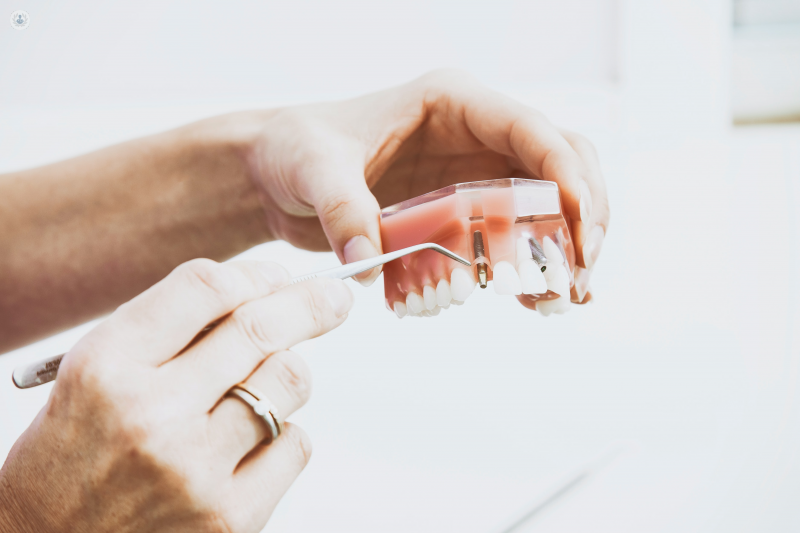Patient factors how long dental implants last
Escrito por:The dental profession in the UK is currently placing around 150,000 dental implants per year, which may be a conservative estimate. This is expected double in the next 10 years.
At least 10% of these implants will have significant problems that will lead to their loss within the first decade. Many others, perhaps even up to half, will exhibit signs of deterioration or failure over time.
In this article Dr Koray Feran, an implant and restorative dental surgeon based in London, explains what a successful and failing dental implant looks like and what patient factors will contribute to its long-term success.

How can dental implant deterioration present?
Dental implant deterioration may present biologically as gum recession, inflammation of the soft tissues around the implant or infection of the implant with progressive bone loss leading to possible implant loss.
The deterioration or failure of the dental restoration on the implants may also be mechanical with breakage of the implant or the components that it supports.
What are the features of a successful and failing dental implant?
Implants are normally categorised as being successful, ailing or failing.
- Successful
Those that are successful have stable supporting bone levels and healthy gum tissue and are in normal day-to-day function. They are usually designed to be mechanically stable and easily accessible for cleaning by the patient and the dental hygienist on a regular basis.
- Ailing
Those that are ailing normally have some level of inflammation that requires intensive localised treatment but can be maintained over a period of time. The maintenance, however, is more challenging than that required for a healthy implant.
- Failing
A failing implant is one where inflammation or infection around the implant has led to substantial bone and tissue loss and the implant is best removed to prevent further bone loss and local tissue damage. These scenarios will require not only for the implant to be replaced but also for the damaged bone and gum to be regenerated. This procedure is often considerably more cost and time-intensive than the original placement of the implant.
Patient factors that influence long-term implant success
It has become apparent over the last three decades that biological implant success is heavily dependent on the health of the patient receiving the implants. The “host response” is critical in the long-term success of implants and cannot always be controlled.
Patients with compromised medical histories or unsuitable host genetics contribute heavily to biological failure. This presents as implant failures clustering around a section of the population.
This failure may manifest as the implant simply not “taking” or fusing to the bone (a process known as osseointegration). More commonly, it manifests as a low-grade and chronic reaction to the dental implant and the components that attach to it that leads to gradual and progressive deterioration and recession of the supporting bone and gum tissue. This is known initially as peri-implant mucositis (inflammation and bleeding of the gum around the implant) which then progresses to peri-implantitis (where the bone around the implant is lost and the implant surface becomes contaminated with bacteria).
The most common causes of implant failure are associated with patients who have one or more of the following features in their medical and dental history:
- Smoking
- Uncontrolled diabetes
- History of advanced gum disease (periodontitis)
- Specific genetic profiles that are involved with immune system regulation, bodily inflammatory response and bone metabolism
- Medications or medical conditions that affect bone metabolism and the inflammatory response
- Poor plaque control due to inadequate home cleaning and infrequent and inadequate dental hygiene follow-up and maintenance.
However, the statistics suggest that with the numbers of implants being placed and the percentage of dental implants that have progressive problems, the dental profession will be spending considerably more time on the remedial aspects of implant treatment that have already been carried out.
Patients should be aware that whilst modern implantology has a great deal to offer and can provide immense confidence to restore function and appearance, dental implants are a long-term commitment and have their fair share of complications that should not be underestimated.
How should patients take care of their implants?
Patients must be aware that dental implants, like natural teeth, require a high level of daily care including brushing, flossing and use of other dental cleaning aids and very regular checkup and hygiene appointments.
There is an excellent correlation between the longevity of dental implants and the frequency of good quality hygiene care. Conversely, there is also an excellent correlation between the prevalence of implants with severe problems and a lack of follow-up care after treatment.
Dental implants may require a level of maintenance that may cost far more time and money than the original treatment if complications arise. Such complications should be diagnosed and treated promptly without delay. Investing in regular high-quality, documented dental hygiene maintenance is the single best way of limiting complications.
In his next article, Dr Koray Feran will discuss the important steps your dental practitioner needs to address correctly when the dental implant treatment is being carried out. He also offers a realistic estimation of how long a you can expect their new implants to last.
Dr Koray Feran is both a consultant dental surgeon and the Clinical Director at The London Centre for Implant and Aesthetic Dentistry. To make an appointment with him, visit his Top Doctors profile and check his availability.


